The Simon Gittany Murder Case: Criminal Law Questions
VerifiedAdded on 2023/04/21
|8
|1962
|356
AI Summary
This document discusses the criminal law questions related to the Simon Gittany murder case. It covers topics such as the type of homicide, main characteristics of the offender and victim, similarities and differences with common patterns, warning signs, and potential guardians. The case study provides insights into intimate partner homicide and the dynamics involved in such cases.
Contribute Materials
Your contribution can guide someone’s learning journey. Share your
documents today.
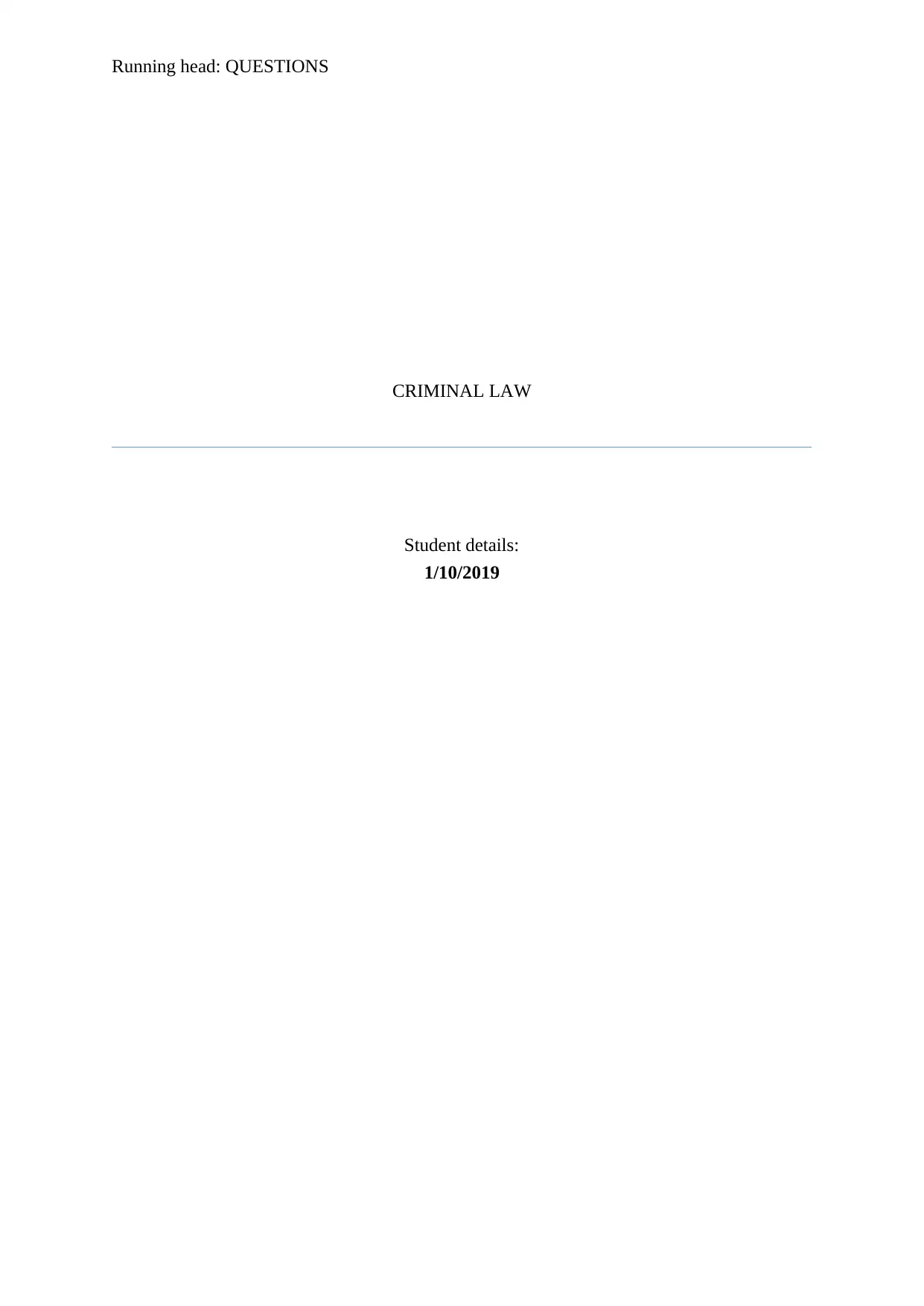
Running head: QUESTIONS
CRIMINAL LAW
Student details:
1/10/2019
CRIMINAL LAW
Student details:
1/10/2019
Secure Best Marks with AI Grader
Need help grading? Try our AI Grader for instant feedback on your assignments.
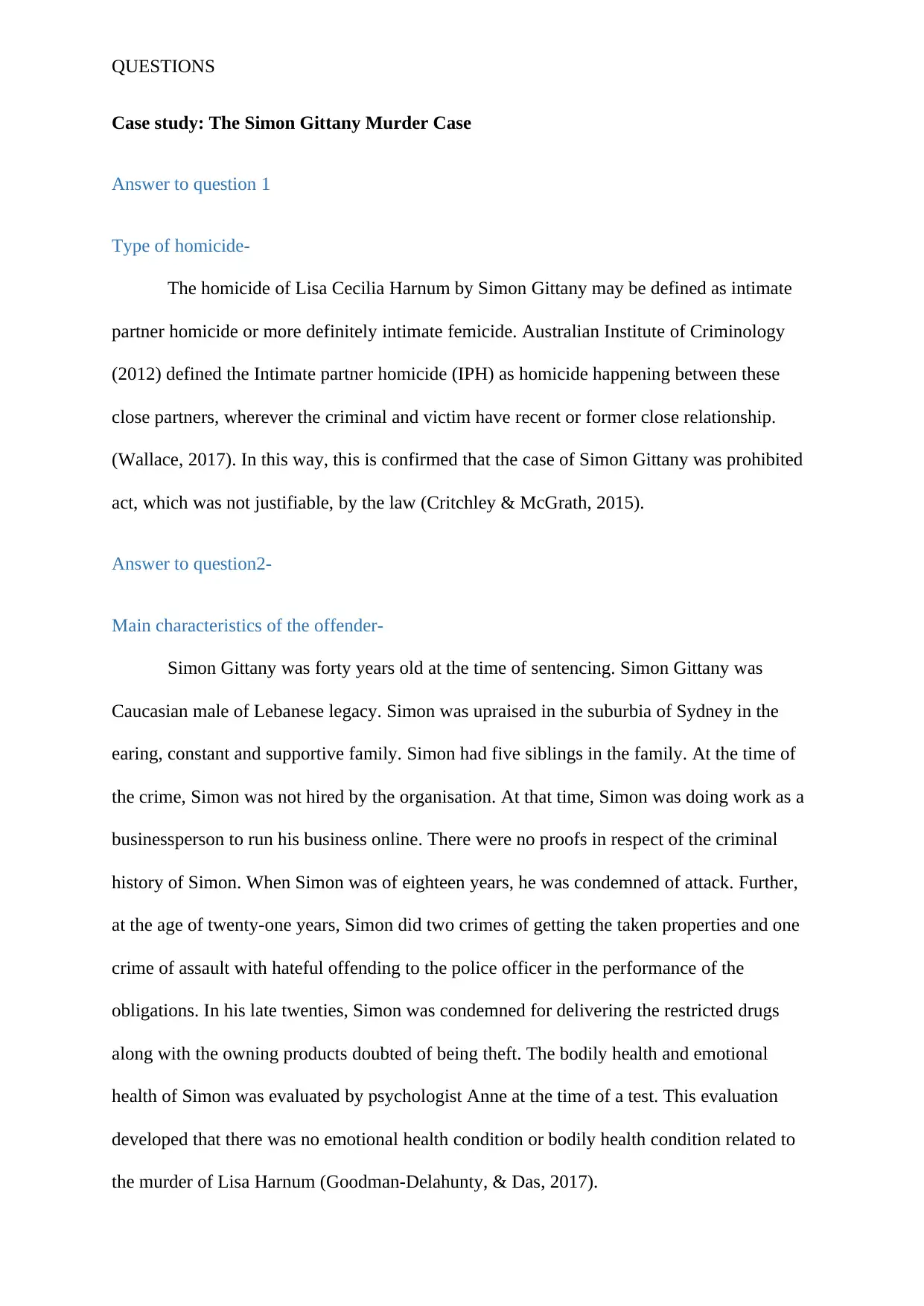
QUESTIONS
Case study: The Simon Gittany Murder Case
Answer to question 1
Type of homicide-
The homicide of Lisa Cecilia Harnum by Simon Gittany may be defined as intimate
partner homicide or more definitely intimate femicide. Australian Institute of Criminology
(2012) defined the Intimate partner homicide (IPH) as homicide happening between these
close partners, wherever the criminal and victim have recent or former close relationship.
(Wallace, 2017). In this way, this is confirmed that the case of Simon Gittany was prohibited
act, which was not justifiable, by the law (Critchley & McGrath, 2015).
Answer to question2-
Main characteristics of the offender-
Simon Gittany was forty years old at the time of sentencing. Simon Gittany was
Caucasian male of Lebanese legacy. Simon was upraised in the suburbia of Sydney in the
earing, constant and supportive family. Simon had five siblings in the family. At the time of
the crime, Simon was not hired by the organisation. At that time, Simon was doing work as a
businessperson to run his business online. There were no proofs in respect of the criminal
history of Simon. When Simon was of eighteen years, he was condemned of attack. Further,
at the age of twenty-one years, Simon did two crimes of getting the taken properties and one
crime of assault with hateful offending to the police officer in the performance of the
obligations. In his late twenties, Simon was condemned for delivering the restricted drugs
along with the owning products doubted of being theft. The bodily health and emotional
health of Simon was evaluated by psychologist Anne at the time of a test. This evaluation
developed that there was no emotional health condition or bodily health condition related to
the murder of Lisa Harnum (Goodman-Delahunty, & Das, 2017).
Case study: The Simon Gittany Murder Case
Answer to question 1
Type of homicide-
The homicide of Lisa Cecilia Harnum by Simon Gittany may be defined as intimate
partner homicide or more definitely intimate femicide. Australian Institute of Criminology
(2012) defined the Intimate partner homicide (IPH) as homicide happening between these
close partners, wherever the criminal and victim have recent or former close relationship.
(Wallace, 2017). In this way, this is confirmed that the case of Simon Gittany was prohibited
act, which was not justifiable, by the law (Critchley & McGrath, 2015).
Answer to question2-
Main characteristics of the offender-
Simon Gittany was forty years old at the time of sentencing. Simon Gittany was
Caucasian male of Lebanese legacy. Simon was upraised in the suburbia of Sydney in the
earing, constant and supportive family. Simon had five siblings in the family. At the time of
the crime, Simon was not hired by the organisation. At that time, Simon was doing work as a
businessperson to run his business online. There were no proofs in respect of the criminal
history of Simon. When Simon was of eighteen years, he was condemned of attack. Further,
at the age of twenty-one years, Simon did two crimes of getting the taken properties and one
crime of assault with hateful offending to the police officer in the performance of the
obligations. In his late twenties, Simon was condemned for delivering the restricted drugs
along with the owning products doubted of being theft. The bodily health and emotional
health of Simon was evaluated by psychologist Anne at the time of a test. This evaluation
developed that there was no emotional health condition or bodily health condition related to
the murder of Lisa Harnum (Goodman-Delahunty, & Das, 2017).
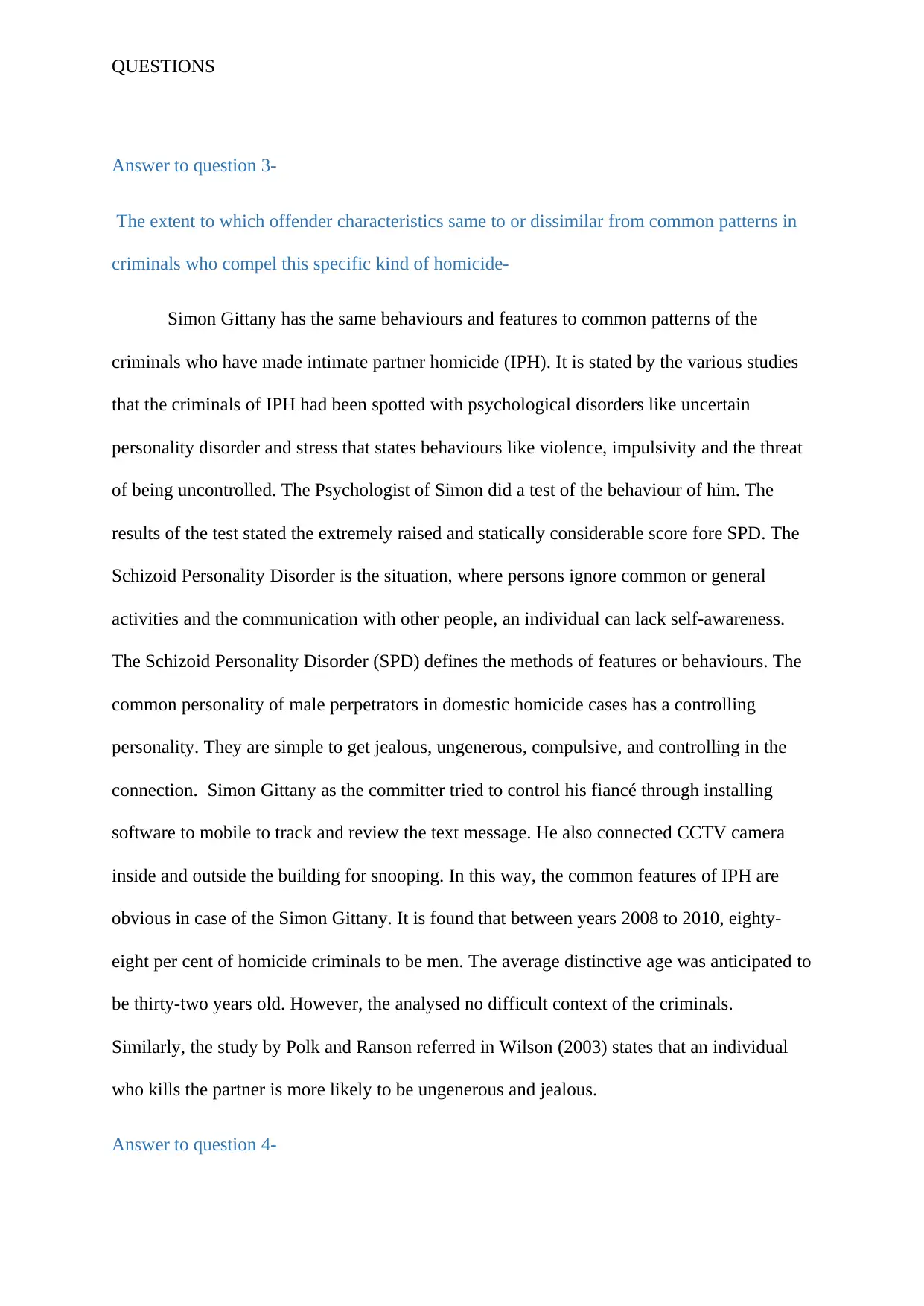
QUESTIONS
Answer to question 3-
The extent to which offender characteristics same to or dissimilar from common patterns in
criminals who compel this specific kind of homicide-
Simon Gittany has the same behaviours and features to common patterns of the
criminals who have made intimate partner homicide (IPH). It is stated by the various studies
that the criminals of IPH had been spotted with psychological disorders like uncertain
personality disorder and stress that states behaviours like violence, impulsivity and the threat
of being uncontrolled. The Psychologist of Simon did a test of the behaviour of him. The
results of the test stated the extremely raised and statically considerable score fore SPD. The
Schizoid Personality Disorder is the situation, where persons ignore common or general
activities and the communication with other people, an individual can lack self-awareness.
The Schizoid Personality Disorder (SPD) defines the methods of features or behaviours. The
common personality of male perpetrators in domestic homicide cases has a controlling
personality. They are simple to get jealous, ungenerous, compulsive, and controlling in the
connection. Simon Gittany as the committer tried to control his fiancé through installing
software to mobile to track and review the text message. He also connected CCTV camera
inside and outside the building for snooping. In this way, the common features of IPH are
obvious in case of the Simon Gittany. It is found that between years 2008 to 2010, eighty-
eight per cent of homicide criminals to be men. The average distinctive age was anticipated to
be thirty-two years old. However, the analysed no difficult context of the criminals.
Similarly, the study by Polk and Ranson referred in Wilson (2003) states that an individual
who kills the partner is more likely to be ungenerous and jealous.
Answer to question 4-
Answer to question 3-
The extent to which offender characteristics same to or dissimilar from common patterns in
criminals who compel this specific kind of homicide-
Simon Gittany has the same behaviours and features to common patterns of the
criminals who have made intimate partner homicide (IPH). It is stated by the various studies
that the criminals of IPH had been spotted with psychological disorders like uncertain
personality disorder and stress that states behaviours like violence, impulsivity and the threat
of being uncontrolled. The Psychologist of Simon did a test of the behaviour of him. The
results of the test stated the extremely raised and statically considerable score fore SPD. The
Schizoid Personality Disorder is the situation, where persons ignore common or general
activities and the communication with other people, an individual can lack self-awareness.
The Schizoid Personality Disorder (SPD) defines the methods of features or behaviours. The
common personality of male perpetrators in domestic homicide cases has a controlling
personality. They are simple to get jealous, ungenerous, compulsive, and controlling in the
connection. Simon Gittany as the committer tried to control his fiancé through installing
software to mobile to track and review the text message. He also connected CCTV camera
inside and outside the building for snooping. In this way, the common features of IPH are
obvious in case of the Simon Gittany. It is found that between years 2008 to 2010, eighty-
eight per cent of homicide criminals to be men. The average distinctive age was anticipated to
be thirty-two years old. However, the analysed no difficult context of the criminals.
Similarly, the study by Polk and Ranson referred in Wilson (2003) states that an individual
who kills the partner is more likely to be ungenerous and jealous.
Answer to question 4-
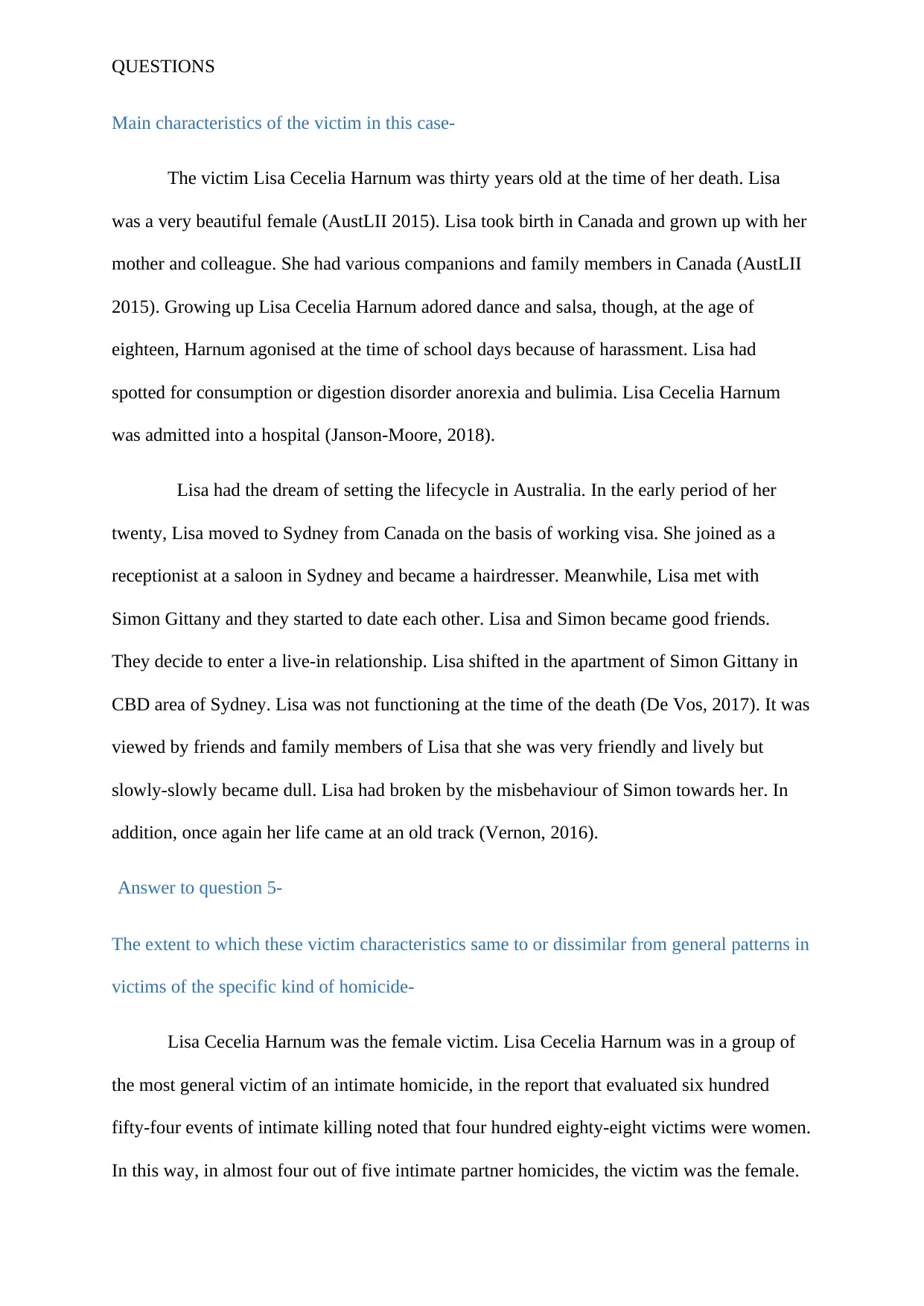
QUESTIONS
Main characteristics of the victim in this case-
The victim Lisa Cecelia Harnum was thirty years old at the time of her death. Lisa
was a very beautiful female (AustLII 2015). Lisa took birth in Canada and grown up with her
mother and colleague. She had various companions and family members in Canada (AustLII
2015). Growing up Lisa Cecelia Harnum adored dance and salsa, though, at the age of
eighteen, Harnum agonised at the time of school days because of harassment. Lisa had
spotted for consumption or digestion disorder anorexia and bulimia. Lisa Cecelia Harnum
was admitted into a hospital (Janson-Moore, 2018).
Lisa had the dream of setting the lifecycle in Australia. In the early period of her
twenty, Lisa moved to Sydney from Canada on the basis of working visa. She joined as a
receptionist at a saloon in Sydney and became a hairdresser. Meanwhile, Lisa met with
Simon Gittany and they started to date each other. Lisa and Simon became good friends.
They decide to enter a live-in relationship. Lisa shifted in the apartment of Simon Gittany in
CBD area of Sydney. Lisa was not functioning at the time of the death (De Vos, 2017). It was
viewed by friends and family members of Lisa that she was very friendly and lively but
slowly-slowly became dull. Lisa had broken by the misbehaviour of Simon towards her. In
addition, once again her life came at an old track (Vernon, 2016).
Answer to question 5-
The extent to which these victim characteristics same to or dissimilar from general patterns in
victims of the specific kind of homicide-
Lisa Cecelia Harnum was the female victim. Lisa Cecelia Harnum was in a group of
the most general victim of an intimate homicide, in the report that evaluated six hundred
fifty-four events of intimate killing noted that four hundred eighty-eight victims were women.
In this way, in almost four out of five intimate partner homicides, the victim was the female.
Main characteristics of the victim in this case-
The victim Lisa Cecelia Harnum was thirty years old at the time of her death. Lisa
was a very beautiful female (AustLII 2015). Lisa took birth in Canada and grown up with her
mother and colleague. She had various companions and family members in Canada (AustLII
2015). Growing up Lisa Cecelia Harnum adored dance and salsa, though, at the age of
eighteen, Harnum agonised at the time of school days because of harassment. Lisa had
spotted for consumption or digestion disorder anorexia and bulimia. Lisa Cecelia Harnum
was admitted into a hospital (Janson-Moore, 2018).
Lisa had the dream of setting the lifecycle in Australia. In the early period of her
twenty, Lisa moved to Sydney from Canada on the basis of working visa. She joined as a
receptionist at a saloon in Sydney and became a hairdresser. Meanwhile, Lisa met with
Simon Gittany and they started to date each other. Lisa and Simon became good friends.
They decide to enter a live-in relationship. Lisa shifted in the apartment of Simon Gittany in
CBD area of Sydney. Lisa was not functioning at the time of the death (De Vos, 2017). It was
viewed by friends and family members of Lisa that she was very friendly and lively but
slowly-slowly became dull. Lisa had broken by the misbehaviour of Simon towards her. In
addition, once again her life came at an old track (Vernon, 2016).
Answer to question 5-
The extent to which these victim characteristics same to or dissimilar from general patterns in
victims of the specific kind of homicide-
Lisa Cecelia Harnum was the female victim. Lisa Cecelia Harnum was in a group of
the most general victim of an intimate homicide, in the report that evaluated six hundred
fifty-four events of intimate killing noted that four hundred eighty-eight victims were women.
In this way, in almost four out of five intimate partner homicides, the victim was the female.
Secure Best Marks with AI Grader
Need help grading? Try our AI Grader for instant feedback on your assignments.
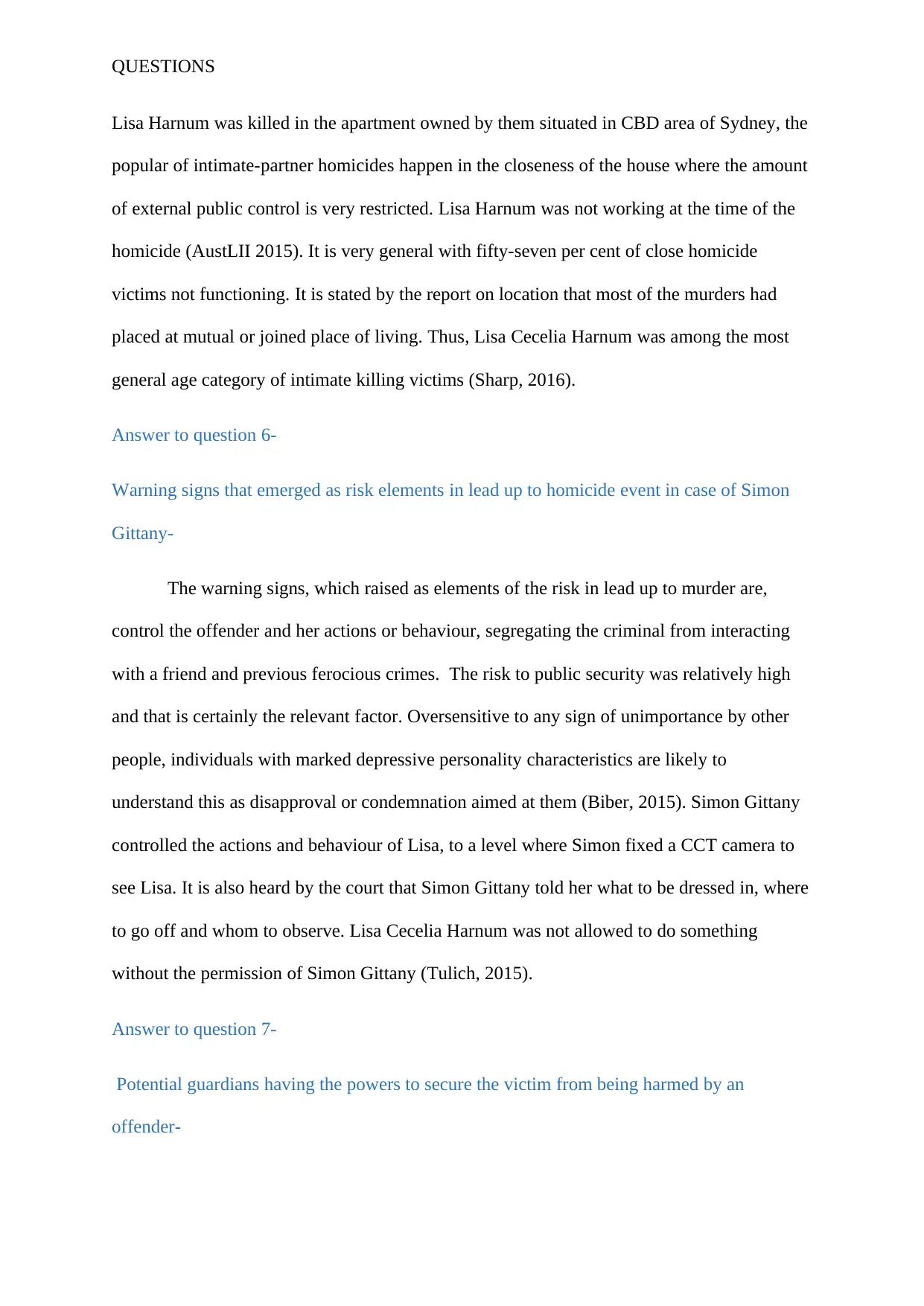
QUESTIONS
Lisa Harnum was killed in the apartment owned by them situated in CBD area of Sydney, the
popular of intimate-partner homicides happen in the closeness of the house where the amount
of external public control is very restricted. Lisa Harnum was not working at the time of the
homicide (AustLII 2015). It is very general with fifty-seven per cent of close homicide
victims not functioning. It is stated by the report on location that most of the murders had
placed at mutual or joined place of living. Thus, Lisa Cecelia Harnum was among the most
general age category of intimate killing victims (Sharp, 2016).
Answer to question 6-
Warning signs that emerged as risk elements in lead up to homicide event in case of Simon
Gittany-
The warning signs, which raised as elements of the risk in lead up to murder are,
control the offender and her actions or behaviour, segregating the criminal from interacting
with a friend and previous ferocious crimes. The risk to public security was relatively high
and that is certainly the relevant factor. Oversensitive to any sign of unimportance by other
people, individuals with marked depressive personality characteristics are likely to
understand this as disapproval or condemnation aimed at them (Biber, 2015). Simon Gittany
controlled the actions and behaviour of Lisa, to a level where Simon fixed a CCT camera to
see Lisa. It is also heard by the court that Simon Gittany told her what to be dressed in, where
to go off and whom to observe. Lisa Cecelia Harnum was not allowed to do something
without the permission of Simon Gittany (Tulich, 2015).
Answer to question 7-
Potential guardians having the powers to secure the victim from being harmed by an
offender-
Lisa Harnum was killed in the apartment owned by them situated in CBD area of Sydney, the
popular of intimate-partner homicides happen in the closeness of the house where the amount
of external public control is very restricted. Lisa Harnum was not working at the time of the
homicide (AustLII 2015). It is very general with fifty-seven per cent of close homicide
victims not functioning. It is stated by the report on location that most of the murders had
placed at mutual or joined place of living. Thus, Lisa Cecelia Harnum was among the most
general age category of intimate killing victims (Sharp, 2016).
Answer to question 6-
Warning signs that emerged as risk elements in lead up to homicide event in case of Simon
Gittany-
The warning signs, which raised as elements of the risk in lead up to murder are,
control the offender and her actions or behaviour, segregating the criminal from interacting
with a friend and previous ferocious crimes. The risk to public security was relatively high
and that is certainly the relevant factor. Oversensitive to any sign of unimportance by other
people, individuals with marked depressive personality characteristics are likely to
understand this as disapproval or condemnation aimed at them (Biber, 2015). Simon Gittany
controlled the actions and behaviour of Lisa, to a level where Simon fixed a CCT camera to
see Lisa. It is also heard by the court that Simon Gittany told her what to be dressed in, where
to go off and whom to observe. Lisa Cecelia Harnum was not allowed to do something
without the permission of Simon Gittany (Tulich, 2015).
Answer to question 7-
Potential guardians having the powers to secure the victim from being harmed by an
offender-
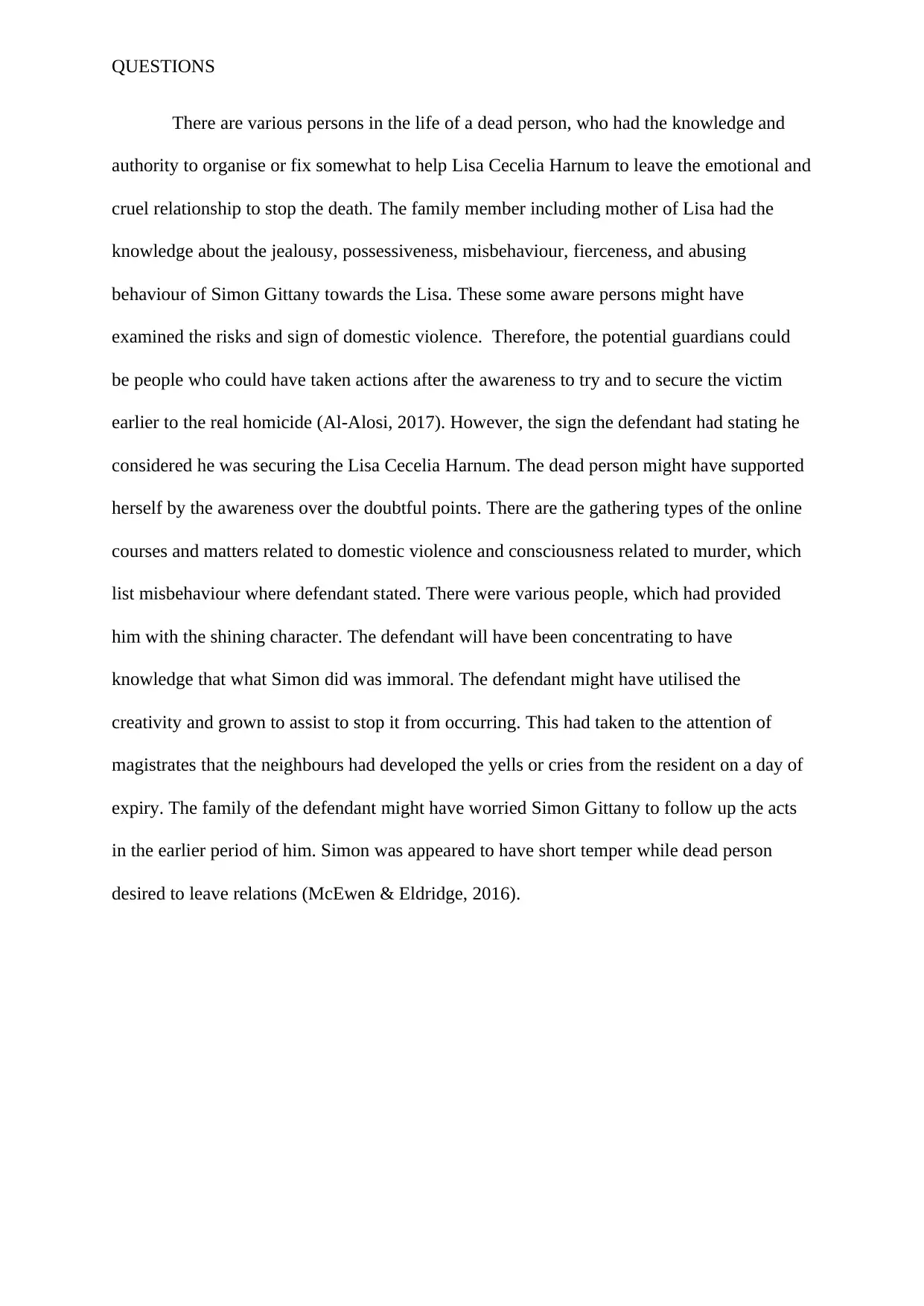
QUESTIONS
There are various persons in the life of a dead person, who had the knowledge and
authority to organise or fix somewhat to help Lisa Cecelia Harnum to leave the emotional and
cruel relationship to stop the death. The family member including mother of Lisa had the
knowledge about the jealousy, possessiveness, misbehaviour, fierceness, and abusing
behaviour of Simon Gittany towards the Lisa. These some aware persons might have
examined the risks and sign of domestic violence. Therefore, the potential guardians could
be people who could have taken actions after the awareness to try and to secure the victim
earlier to the real homicide (Al-Alosi, 2017). However, the sign the defendant had stating he
considered he was securing the Lisa Cecelia Harnum. The dead person might have supported
herself by the awareness over the doubtful points. There are the gathering types of the online
courses and matters related to domestic violence and consciousness related to murder, which
list misbehaviour where defendant stated. There were various people, which had provided
him with the shining character. The defendant will have been concentrating to have
knowledge that what Simon did was immoral. The defendant might have utilised the
creativity and grown to assist to stop it from occurring. This had taken to the attention of
magistrates that the neighbours had developed the yells or cries from the resident on a day of
expiry. The family of the defendant might have worried Simon Gittany to follow up the acts
in the earlier period of him. Simon was appeared to have short temper while dead person
desired to leave relations (McEwen & Eldridge, 2016).
There are various persons in the life of a dead person, who had the knowledge and
authority to organise or fix somewhat to help Lisa Cecelia Harnum to leave the emotional and
cruel relationship to stop the death. The family member including mother of Lisa had the
knowledge about the jealousy, possessiveness, misbehaviour, fierceness, and abusing
behaviour of Simon Gittany towards the Lisa. These some aware persons might have
examined the risks and sign of domestic violence. Therefore, the potential guardians could
be people who could have taken actions after the awareness to try and to secure the victim
earlier to the real homicide (Al-Alosi, 2017). However, the sign the defendant had stating he
considered he was securing the Lisa Cecelia Harnum. The dead person might have supported
herself by the awareness over the doubtful points. There are the gathering types of the online
courses and matters related to domestic violence and consciousness related to murder, which
list misbehaviour where defendant stated. There were various people, which had provided
him with the shining character. The defendant will have been concentrating to have
knowledge that what Simon did was immoral. The defendant might have utilised the
creativity and grown to assist to stop it from occurring. This had taken to the attention of
magistrates that the neighbours had developed the yells or cries from the resident on a day of
expiry. The family of the defendant might have worried Simon Gittany to follow up the acts
in the earlier period of him. Simon was appeared to have short temper while dead person
desired to leave relations (McEwen & Eldridge, 2016).
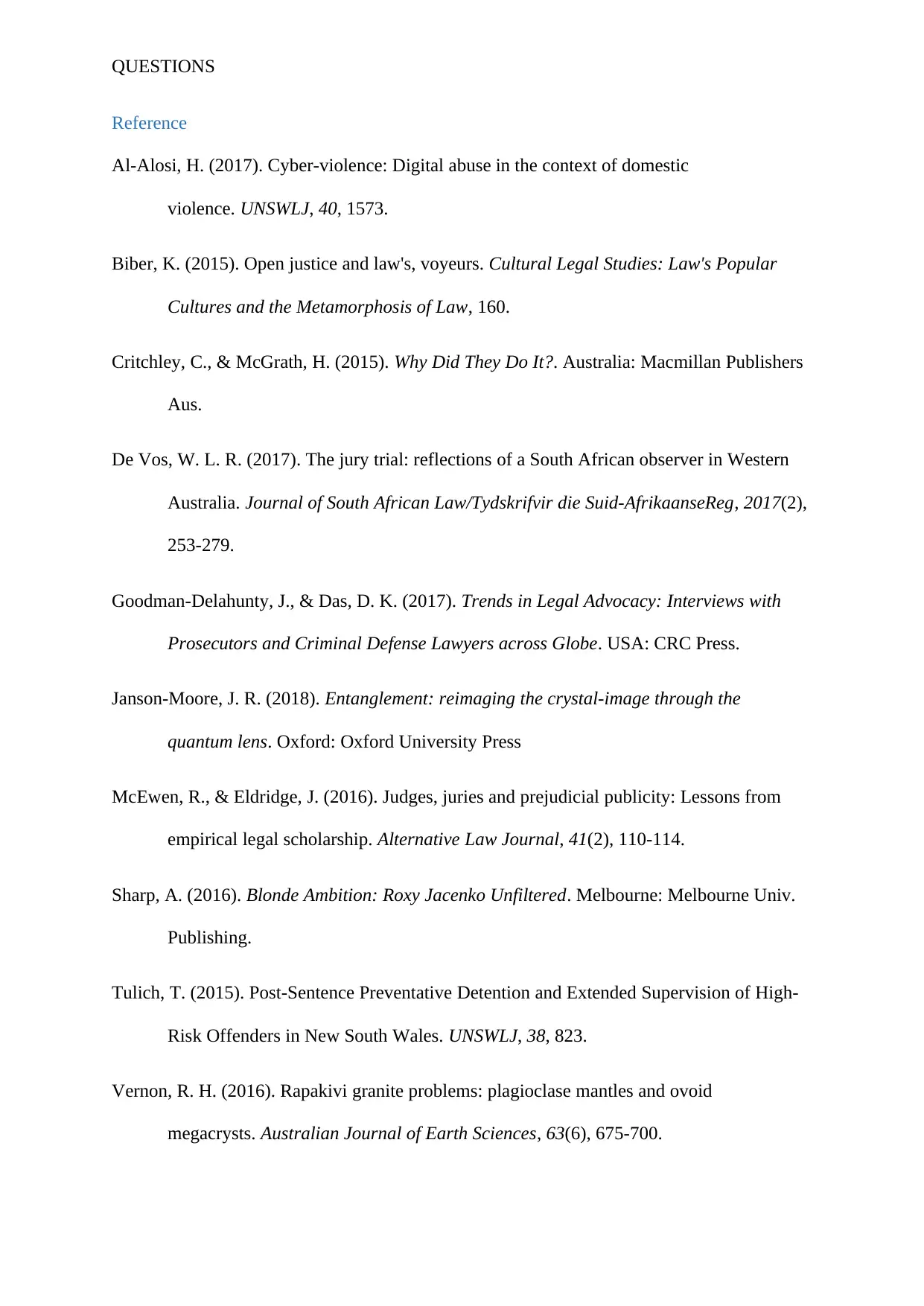
QUESTIONS
Reference
Al-Alosi, H. (2017). Cyber-violence: Digital abuse in the context of domestic
violence. UNSWLJ, 40, 1573.
Biber, K. (2015). Open justice and law's, voyeurs. Cultural Legal Studies: Law's Popular
Cultures and the Metamorphosis of Law, 160.
Critchley, C., & McGrath, H. (2015). Why Did They Do It?. Australia: Macmillan Publishers
Aus.
De Vos, W. L. R. (2017). The jury trial: reflections of a South African observer in Western
Australia. Journal of South African Law/Tydskrifvir die Suid-AfrikaanseReg, 2017(2),
253-279.
Goodman-Delahunty, J., & Das, D. K. (2017). Trends in Legal Advocacy: Interviews with
Prosecutors and Criminal Defense Lawyers across Globe. USA: CRC Press.
Janson-Moore, J. R. (2018). Entanglement: reimaging the crystal-image through the
quantum lens. Oxford: Oxford University Press
McEwen, R., & Eldridge, J. (2016). Judges, juries and prejudicial publicity: Lessons from
empirical legal scholarship. Alternative Law Journal, 41(2), 110-114.
Sharp, A. (2016). Blonde Ambition: Roxy Jacenko Unfiltered. Melbourne: Melbourne Univ.
Publishing.
Tulich, T. (2015). Post-Sentence Preventative Detention and Extended Supervision of High-
Risk Offenders in New South Wales. UNSWLJ, 38, 823.
Vernon, R. H. (2016). Rapakivi granite problems: plagioclase mantles and ovoid
megacrysts. Australian Journal of Earth Sciences, 63(6), 675-700.
Reference
Al-Alosi, H. (2017). Cyber-violence: Digital abuse in the context of domestic
violence. UNSWLJ, 40, 1573.
Biber, K. (2015). Open justice and law's, voyeurs. Cultural Legal Studies: Law's Popular
Cultures and the Metamorphosis of Law, 160.
Critchley, C., & McGrath, H. (2015). Why Did They Do It?. Australia: Macmillan Publishers
Aus.
De Vos, W. L. R. (2017). The jury trial: reflections of a South African observer in Western
Australia. Journal of South African Law/Tydskrifvir die Suid-AfrikaanseReg, 2017(2),
253-279.
Goodman-Delahunty, J., & Das, D. K. (2017). Trends in Legal Advocacy: Interviews with
Prosecutors and Criminal Defense Lawyers across Globe. USA: CRC Press.
Janson-Moore, J. R. (2018). Entanglement: reimaging the crystal-image through the
quantum lens. Oxford: Oxford University Press
McEwen, R., & Eldridge, J. (2016). Judges, juries and prejudicial publicity: Lessons from
empirical legal scholarship. Alternative Law Journal, 41(2), 110-114.
Sharp, A. (2016). Blonde Ambition: Roxy Jacenko Unfiltered. Melbourne: Melbourne Univ.
Publishing.
Tulich, T. (2015). Post-Sentence Preventative Detention and Extended Supervision of High-
Risk Offenders in New South Wales. UNSWLJ, 38, 823.
Vernon, R. H. (2016). Rapakivi granite problems: plagioclase mantles and ovoid
megacrysts. Australian Journal of Earth Sciences, 63(6), 675-700.
Paraphrase This Document
Need a fresh take? Get an instant paraphrase of this document with our AI Paraphraser

QUESTIONS
Wallace, A. (2017). Australia The Criminal Justice Process of Australia. USA: CRC Press.
Wallace, A. (2017). Australia The Criminal Justice Process of Australia. USA: CRC Press.
1 out of 8
Your All-in-One AI-Powered Toolkit for Academic Success.
+13062052269
info@desklib.com
Available 24*7 on WhatsApp / Email
![[object Object]](/_next/static/media/star-bottom.7253800d.svg)
Unlock your academic potential
© 2024 | Zucol Services PVT LTD | All rights reserved.

